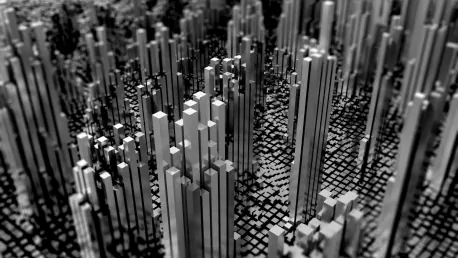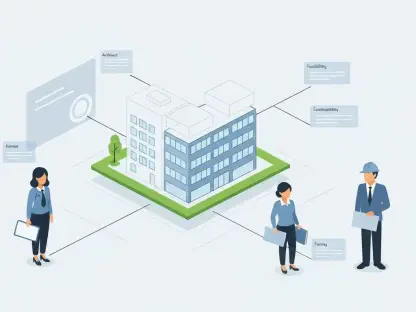The 3D printing construction market has been on an extraordinary growth trajectory, showcasing its potential to revolutionize the construction industry. Evaluated at USD 1.4 billion in 2019, the market is projected to skyrocket to USD 397.5 billion by 2031. This remarkable expansion is driven by technological advancements, a growing demand for sustainable construction practices, and significant investments from key market players and venture capitalists. As the construction industry continues to evolve and embrace new technologies, 3D printing stands out as a transformative force that promises to reshape the way buildings and structures are designed and constructed.
Over the past few years, the construction sector has been under immense pressure to innovate and adopt more efficient and eco-friendly practices. This has created a ripe environment for 3D printing technology to flourish. Offering the ability to create complex structures with unprecedented precision, speed, and cost-effectiveness, 3D printing is rapidly becoming a cornerstone of modern construction methods. As investments continue to pour in and technology advances, the potential applications for 3D printing in construction are expanding, leading to increased interest from stakeholders across various industries.
Technological Innovations and Advancements
The rapid advancements in 3D printing technology are a major driving force behind the market’s explosive growth. New printing techniques such as Fused Deposition Modeling (FDM), Wire Arc Additive Manufacturing (WAAM), and Big Area Additive Manufacturing (BAAM) are transforming the construction landscape. These methods enable the creation of complex structures with greater precision and efficiency, reducing costs and accelerating project timelines. The capability to build large-scale structures quickly and accurately is revolutionizing how construction projects are planned and executed.
More sophisticated techniques like Stereolithography (SLA) and Selective Laser Sintering (SLS) are also gaining traction. These technologies allow for the production of intricate designs and high-quality finishes, further expanding the possibilities of 3D printing in construction. As these innovations continue to evolve, they are expected to play a pivotal role in shaping the future of the industry. The integration of advanced software and hardware solutions is another key factor contributing to the market’s growth.
These tools enhance the capabilities of 3D printing technology, enabling more accurate and efficient construction processes. As a result, companies are able to deliver higher-quality projects while minimizing waste and reducing environmental impact. The synergy between software advancements and hardware improvements is driving the adoption of 3D printing across various construction segments. This not only helps in addressing the growing demand for innovative construction solutions but also paves the way for new opportunities in the industry.
Increased Demand for Sustainability
The construction industry is increasingly focusing on sustainability, and 3D printing is well-positioned to address these concerns. The use of environmentally friendly materials and the reduction of waste are key benefits of 3D printing construction. By adopting circular economy principles, companies can minimize waste and make the most of available resources, contributing to a more sustainable future. This approach aligns with the global push towards more environmentally conscious practices and provides an effective solution to some of the industry’s most pressing challenges.
Energy-efficient designs are another significant advantage of 3D printing construction. These designs can help reduce energy consumption and lower greenhouse gas emissions, making buildings more sustainable and environmentally friendly. As the demand for green construction practices continues to grow, 3D printing is expected to play a crucial role in meeting these needs. The ability to produce customized and innovative designs is also driving the adoption of 3D printing in construction.
This flexibility allows architects and builders to create unique structures that are both aesthetically pleasing and environmentally responsible. As more companies recognize the benefits of 3D printing, the market is poised for continued growth. The incorporation of sustainable practices not only enhances the appeal of 3D printing but also positions it as a vital tool in the broader effort to combat climate change.
Competitive Landscape and Strategic Initiatives
The 3D printing construction market is characterized by intense competition, with both established firms and new entrants striving to capture market share. Companies like Yingchuang Building Technique, XtreeE, Apis Cor, and Monolite UK are at the forefront of this market, engaging in various strategic initiatives to strengthen their positions. These companies are leveraging their expertise and resources to drive innovation and set new benchmarks in the industry.
Mergers and acquisitions are a common strategy among market players, allowing them to expand their capabilities and market presence. Partnerships and collaborations are also prevalent, enabling companies to leverage each other’s strengths and drive innovation. By working together, these firms can accelerate the development and adoption of 3D printing technology in construction. Continual innovation is another key focus for market players. By investing in research and development, companies can stay ahead of the competition and deliver cutting-edge solutions to their customers.
Expanding geographical footprints is also a priority, as firms seek to tap into new markets and capitalize on emerging opportunities. The strategic initiatives undertaken by these companies are not only aimed at enhancing their market standing but also at fostering a culture of continual improvement and adaptation. This dynamic environment encourages the development of new technologies and methodologies that can have a lasting impact on the construction industry.
Market Segmentation and Applications
The 3D printing construction market is diverse, with various applications, materials, and technologies driving its growth. Key applications include concept models, visual arts, tooling, and functional models, each offering unique benefits and opportunities for innovation. These applications showcase the versatility of 3D printing and its potential to revolutionize different aspects of the construction industry. The ability to quickly produce accurate models and prototypes is invaluable in reducing development times and costs.
Materials used in 3D printing construction range from concrete and plastics to metals and ceramics. Each material has its own advantages and is suited to different types of projects. For example, concrete is ideal for large-scale structures, while plastics and metals are better suited for intricate designs and smaller components. The diversity of available materials ensures that 3D printing can be applied to a wide range of construction needs, offering flexibility and customization to meet specific project requirements.
Printing technologies such as FDM, WAAM, BAAM, SLA, and SLS are all contributing to the market’s growth. These methods offer different capabilities and benefits, allowing companies to choose the best technology for their specific needs. As these technologies continue to evolve, they are expected to drive further innovation and growth in the market. The continuous improvement of printing technologies is essential for addressing the varied demands of the construction industry and ensuring that 3D printing remains a viable option for different applications.
Geographical Insights and Regional Dynamics
The 3D printing construction market is experiencing growth across various regions, each presenting unique opportunities and challenges. North America, Europe, Asia-Pacific, the Middle East and Africa, and South America are all key regions analyzed in the study. Each of these regions has its own set of drivers and constraints that influence the adoption and growth of 3D printing technology in construction.
In North America, the market is driven by technological advancements and a strong focus on sustainability. The USA, Canada, and Mexico are leading the way in adopting 3D printing construction practices, with numerous projects showcasing the potential of this technology. Europe is another significant market, with countries like Germany, France, and the UK at the forefront of innovation. The region’s strong emphasis on sustainability and regulatory support for green building practices further bolster the adoption of 3D printing construction technologies.
In Asia-Pacific, countries such as China, Japan, and South Korea are rapidly embracing 3D printing in construction. The region’s growing urbanization and infrastructure development needs are key factors driving the demand for innovative construction solutions. The Middle East and Africa region is also witnessing increased adoption of 3D printing technology, with a focus on sustainable and efficient construction methods. In South America, Brazil and Argentina are emerging as key players in the 3D printing construction market, driven by economic growth and the need for modern infrastructure.
The geographical insights provided in the study highlight the diverse factors influencing the adoption of 3D printing technology in different regions. Understanding these regional dynamics is crucial for market players looking to expand their presence and capitalize on emerging opportunities. Each region offers unique challenges and opportunities that can shape the future trajectory of the 3D printing construction market.
Strategic Insights
SkyQuest’s comprehensive analysis uncovers critical insights about the market drivers, constraints, and opportunities. The increasing demand for sustainable construction methods, the rising adoption of digital technologies, and the innovative strides in 3D printing technology are propelling market growth. However, market players also need to navigate challenges such as high initial investment costs, regulatory hurdles, and the need for further technological advancements to fully realize the potential of 3D printing in construction. The complex landscape requires a strategic approach to ensure long-term success and growth.
The report also presents forecasts for the 3D printing construction market from 2024 to 2031, providing insight into future market dynamics and investment opportunities. The analysts emphasize the importance of strategic planning and innovation for market players aiming to seize emerging opportunities and mitigate potential risks. By understanding the evolving trends and market dynamics, companies can position themselves to take advantage of the growing opportunities in the 3D printing construction sector.
Conclusion
The 3D printing construction market has experienced incredible growth, showcasing its potential to transform the construction industry. Valued at USD 1.4 billion in 2019, it is expected to surge to USD 397.5 billion by 2031. This significant expansion is fueled by technological advances, rising demand for sustainable construction practices, and considerable investments from key market players and venture capitalists. As the construction sector evolves and embraces new technologies, 3D printing emerges as a pivotal force set to reshape the way buildings and structures are designed and built.
In recent years, the construction industry has faced immense pressure to innovate and adopt more efficient and eco-friendly practices. This has created an ideal environment for 3D printing technology to thrive. With its ability to produce complex structures with unparalleled precision, speed, and cost-effectiveness, 3D printing is quickly becoming a cornerstone of modern construction methods. As investments continue and technology progresses, the potential applications for 3D printing in construction continue to grow, attracting increased interest from stakeholders across various industries.









